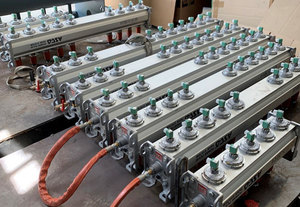Efficient Cleaning of Sustainable Biomass Boilers
Energy Disrupter
Despite its environmental benefits, one significant challenge that comes with biomass combustion is soot and dust buildup
<img src="https://biomassmagazine.com/uploads/posts/magazine/2022/07/resize/Cont1-8MWBoiler_16584122547845-300×300-noup.jpg" title="An example of a solution provided by Emerson to equip an 8-MW (27 MMBtu) biomass boiler. It consists of ASCO Series 355 tanks with immerged ASCO Series 353 valves.
PHOTO: EMERSON</small>”>
<img src="https://biomassmagazine.com/uploads/posts/magazine/2022/07/resize/Cont1-BoilerConnection_16584122548194-300×300-noup.jpg" title="Connection to the boiler’s orifices at the bottom of the ASCO Series 355 tanks with ASCO Series 353 valves
PHOTO: EMERSON</small>”>
ADVERTISEMENT
Humans have burned solid biomass, or plant-based materials, since the discovery of fire. Fast-forward to today, gas and oil are now the go-to fuel sources, contributing to increasing levels of carbon dioxide and other greenhouse gasses in our atmosphere. In the midst of current efforts to reduce carbon emissions, many are turning to biomass again as a potential solution to minimize the global human carbon footprint.
This article explores how automated solutions, particularly systems that use solenoid soot-blowing valves immerged in a pressurized tank, can overcome these issues, improving the soot-cleaning blowing process compared to standalone valve solutions.
Biomass as a Sustainable Fuel Source
Biomass is a sustainable, carbon-neutral fuel since burning the plant-based waste only releases the carbon that was captured during the plant’s life cycle—carbon that would have been released via biodegradation anyway. This fact is a crucial difference between biomass fuel and hydrocarbon fuels like natural gas and oil, which are now being burned and released into the atmosphere in high quantities after being underground for millions of years.
A sustainable source of biomass is agricultural waste. Crop harvests generate significant volumes of plant material, such as stalks and stems, that are not used in the food industry and discarded as waste. Eventually, this waste biodegrades and releases all the carbon the plant absorbed in its lifetime back into the atmosphere. This plant waste can be processed into feedstock for biomass pellets, which can be used as the main fuel for a boiler or steam generator for comfort heating, industrial processes or electric power generation.
Despite these benefits, using biomass as fuel requires understanding the carbon cycle. Cutting down every tree for biomass supply would result in deforestation, for example, throwing off the carbon balance and creating many additional problems. For every plant that is burned, a new one must grow in order to keep the balance. In short, although biomass is a sustainable fuel source that can significantly reduce the carbon footprint of heating industries, we must use it wisely.
The Challenges of Burning Biomass
Using biomass instead of conventional fuels like coal, diesel and natural gas is challenging. One obstacle to overcome is modifying burning equipment to accommodate solid fuels. Another problem, particularly in biomass-fueled boilers, is soot and dust buildup. More problematic than the soot produced by conventional fuels, this soot is “stickier” because it forms as a solid residue with a high moisture content. Soot accumulates in the fire tubes, reduces heat transfer and decreases boiler and heating equipment performance over time, thus increasing costs, lowering efficiency and causing the same amount of fuel to produce less heat.
One soot removal method is to simply stop the boiler, wait for it to cool and then manually clean each tube with a long brush. Unfortunately, this option takes time and typically requires a downtime period of one or two days, halting plant processes, raising costs and hindering production throughput. For industrial applications with high heat output requirements, however, this cleaning process can be a necessary evil each month.
Automated Solutions to Clean Biomass Soot
A more efficient solution is to clean the fire tubes with compressed air, a method that requires installing special solenoid valves for dust and soot blowing. These valves are designed to create a high peak pressure and provide an optimal flow factor to blow the soot out of the system. Valves are connected to a compressed air system and, when opened, pulse air into the tubes.This method automates the cleaning process: operators no longer have to clean each tube, preventing downtime. Instead, a programmable logic controller (PLC) handles the cleaning by orchestrating the solenoid valves. However, keep in mind that not all solutions will perform the same way when it comes to automation.
Typically, when implementing a biomass cleaning system in the field, standalone solenoid valves must be strategically installed at optimal positions, allowing the most tubes to be cleaned. But this method has some limits, requiring you to connect each valve to the compressed air system. The connection layout also limits the pulse pressure. Fortunately, a more practical, powerful solution exists.
Solenoid soot-blowing valves, immerged in a pressurized aluminum tank, are also available and capable of containing a high amount of compressed air at-the-ready for the valves. After the solenoid valve receives an electric signal, it quickly opens and delivers a higher peak of air pressure to the orifices connected to the boilers, creating a blast of air and cleaning the tubes better and more efficiently than standalone valves. These tank assemblies can be customized, allowing the orifices at the bottom of the tank to match the boiler’s door or wall orifices, facilitating soot-blowing system installation.
Standalone valve solutions can usually be replaced with a tank solution with smaller and less immerged valves. In some cases, biomass boiler manufacturers can replace standalone 1.5-inch size valves (DN40) with a tank containing one-inch immerged valves (DN40), achieving higher performance levels and significantly reducing air consumption and installation costs.
Author: Asaël Hervet-Binois
Combustion Product Marketing Manager, Emerson
[email protected]
www.emersonautomationexperts.com
















